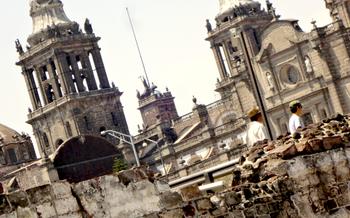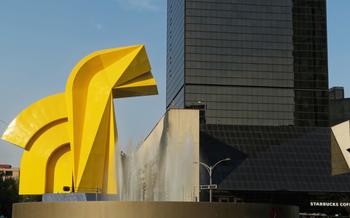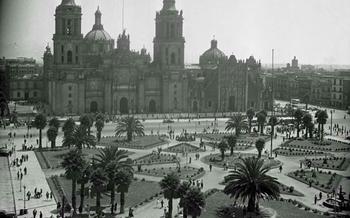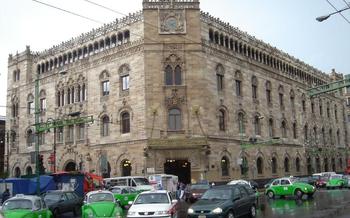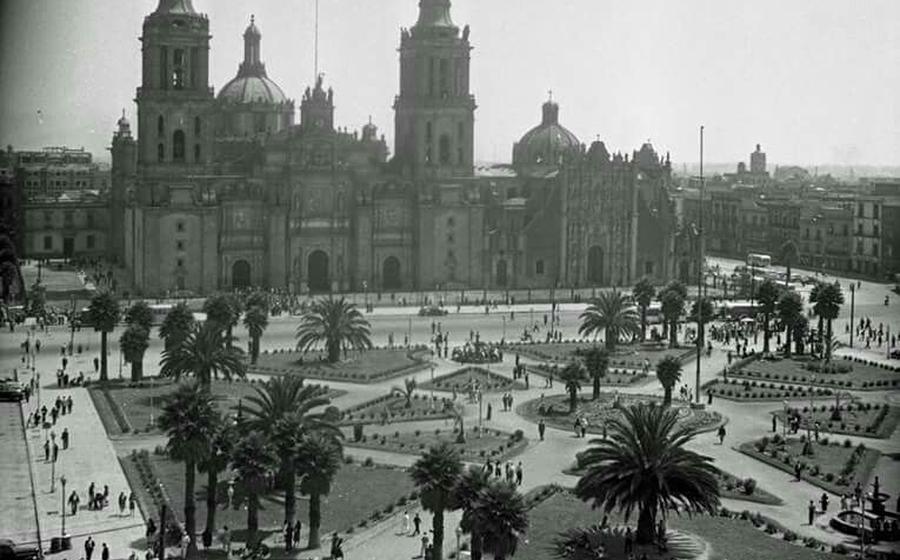
Zócalo (Plaza de la Constitución)
- The Metropolitan Cathedral: A Symbol of Faith
- The National Palace: A Seat of Power
- The Madero Street: A Bustling Commercial Hub
- The Casa de los Azulejos: A Historical Gem
- The Torre Latinoamericana: A Symbol of Modernity
- The Mercado de San Juan: A Culinary Adventure
- Diego Rivera Murals: A Master's Legacy
- The Xochimilco Canals: A Floating Garden Experience
The Metropolitan Cathedral: A Symbol of Faith
The Metropolitan Cathedral stands as a testament to the deep-rooted Catholic faith in Mexico. Constructed over a span of 250 years, from 1573 to 1813, this awe-inspiring edifice blends Gothic, Renaissance, and Baroque architectural styles, showcasing the evolution of artistic expression in Mexico. Its grandeur is further enhanced by the twin bell towers, one of which, due to financial constraints, remained incomplete, adding a touch of asymmetry to its otherwise harmonious facade.
Inside, the cathedral's ornate interior is adorned with intricate carvings, opulent gold leaf, and stunning stained-glass windows that cast a kaleidoscope of colors onto the marble floors. The main altarpiece, a masterpiece of Baroque art, is a testament to the skill and artistry of Mexican craftsmen. The cathedral is also home to a vast collection of religious relics, paintings, and sculptures, each holding a significant place in Mexican Catholic history.
Beyond its religious significance, the Metropolitan Cathedral has played a pivotal role in shaping Mexico's political and social landscape. It has witnessed countless historical events, from the signing of Mexico's independence in 1821 to the coronation of Emperor Maximilian I in 186Today, it remains a vibrant center of worship and a symbol of Mexico's enduring spiritual heritage.
The National Palace: A Seat of Power
The National Palace stands as a testament to Mexico's rich history and enduring power. Constructed on the ruins of Moctezuma II's palace, this magnificent building has served as the official residence of the Mexican president since the mid-19th century. Its opulent interiors and grand murals, particularly those by renowned artist Diego Rivera, captivate visitors with their vibrant depiction of Mexico's history and culture. Rivera's murals, adorning the palace's walls, narrate the story of Mexico's struggle for independence, the Mexican Revolution, and the country's rich cultural heritage. One of the most striking murals, "The History of Mexico," portrays the country's journey from pre-Hispanic times to the modern era.
The Madero Street: A Bustling Commercial Hub
In the heart of Mexico City's historic center, Madero Street stands as a vibrant pedestrian thoroughfare, a shopper's paradise, and a cultural hub. Lined with an array of shops, boutiques, and department stores, it offers a diverse shopping experience catering to every taste and budget. Amidst the retail haven, beautiful historical buildings add to the street's charm, including the Palacio de Bellas Artes and the Casa de los Azulejos.
The street exudes a lively atmosphere, with cafes, restaurants, and bars dotting its length. Visitors can savor authentic Mexican cuisine, sip on refreshing beverages, and soak in the vibrant ambiance. Named after Francisco I. Madero, a key figure in the Mexican Revolution, Madero Street serves as a testament to the city's rich history and vibrant spirit.
The Casa de los Azulejos: A Historical Gem
The Casa de los Azulejos, or "House of Tiles," is a striking architectural gem located in the historic center of Mexico City. Built in the 16th century, the palace is renowned for its stunning facade, which is entirely covered in blue and white Talavera tiles. These tiles, imported from Spain, create a mesmerizing visual effect, making the building one of the most photographed in the city.
Originally constructed as the home of the Count of Orizaba, the palace has served various purposes throughout its history. It has been a mint, a department store, and even a government building. Today, the Casa de los Azulejos houses a branch of the Sanborns restaurant chain, seamlessly blending historical charm with modern-day convenience.
Legend has it that the tiles were originally intended for a church in Puebla but were diverted to the Casa de los Azulejos due to a shipping error. This twist of fate resulted in the creation of one of the city's most iconic landmarks, a testament to the beauty that can arise from unexpected circumstances.
The Torre Latinoamericana: A Symbol of Modernity
Architectural marvel
Soaring high above the heart of Mexico City, the Torre Latinoamericana stands as a testament to the city's modernity and progress. Completed in 1956, this 44-story skyscraper was once the tallest building in Latin America, and it continues to be a symbol of the city's economic and technological prowess. With its striking Art Deco design and intricate detailing, the Torre Latinoamericana is a masterpiece of modern architecture.
Historical significance
The construction of the Torre Latinoamericana was a bold undertaking, reflecting Mexico's growing confidence and ambition in the mid-20th century. It was built on the site of a former convent, and its construction required the use of innovative engineering techniques to withstand the city's frequent earthquakes. The tower's completion in 1956 was a major milestone for Mexico City, and it quickly became a symbol of the city's transformation into a modern metropolis.
Cultural significance
The Torre Latinoamericana has become an iconic landmark of Mexico City, and it has been featured in numerous films, television shows, and works of art. Its distinctive silhouette is instantly recognizable, and it has become a symbol of the city's skyline. The tower's observation deck offers panoramic views of the city, making it a popular destination for tourists and locals alike.
Insider anecdote
The Torre Latinoamericana was designed to withstand earthquakes, and it has successfully survived several major tremors, including the devastating 1985 earthquake. During the earthquake, the tower swayed violently, but it remained standing, a testament to its structural integrity. This remarkable feat of engineering has made the Torre Latinoamericana a symbol of resilience and strength for the people of Mexico City.
The Mercado de San Juan: A Culinary Adventure
Nestled in the heart of Mexico City, the Mercado de San Juan is a culinary paradise that offers a vibrant and authentic Mexican food experience. With its bustling atmosphere, colorful stalls, and mouthwatering aromas, the market is a must-visit for food enthusiasts and travelers seeking a taste of traditional Mexican cuisine.
The market is renowned for its wide variety of fresh ingredients, exotic spices, and traditional dishes. From fresh produce and artisanal cheeses to dried chiles and exotic herbs, the Mercado de San Juan has everything a food lover could desire. Visitors can also sample authentic Mexican street food, such as tacos, tamales, and enchiladas, prepared by local vendors who have perfected their recipes over generations.
For those who want to delve deeper into Mexican culinary traditions, the market offers cooking classes where visitors can learn how to prepare traditional dishes using fresh ingredients. These classes are a great way to learn about the history and techniques of Mexican cuisine and to bring a taste of Mexico back home.
Insider anecdote: The Mercado de San Juan is a popular spot for chefs and food enthusiasts who come to source unique ingredients and learn about Mexican culinary traditions. The market is also a great place to find traditional ingredients for Mexican dishes that are difficult to find outside of Mexico.
Diego Rivera Murals: A Master's Legacy
Mexico City is home to a treasure trove of stunning murals by renowned Mexican artist Diego Rivera. These masterpieces, scattered throughout the city's historic buildings, offer a unique and profound insight into Mexican history, culture, and social struggles. Among the most notable are the murals at the National Palace, which depict the epic story of Mexico from pre-Columbian times to the Mexican Revolution. Equally impressive are the murals at the Palacio de Bellas Artes, which explore the evolution of Mexican art and culture. Rivera's murals are not only artistic masterpieces but also powerful political statements, often challenging the status quo and advocating for social justice. His legacy continues to inspire and provoke, making him one of the most influential artists of the 20th century.
The Xochimilco Canals: A Floating Garden Experience
Just south of Mexico City, the Xochimilco canals offer a unique and tranquil escape from the hustle and bustle of the city. A network of waterways and canals, Xochimilco is a UNESCO World Heritage Site and a popular spot for both locals and tourists. Visitors can take a ride on a traditional trajinera, a colorful boat decorated with flowers and music, while admiring the surrounding scenery. The canals are lined with floating gardens, known as chinampas, where locals grow flowers, vegetables, and herbs. These chinampas are a testament to the ingenuity of the Aztecs, who created these artificial islands to expand their agricultural land.
Insider anecdote: The Xochimilco canals were once part of the Aztec city of Tenochtitlan, and they were used for transportation and agriculture. Today, Xochimilco is a popular spot for locals to celebrate holidays and special occasions, and it's not uncommon to see families and friends enjoying a day out on the water, eating, drinking, and listening to music.
